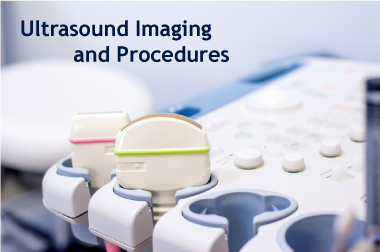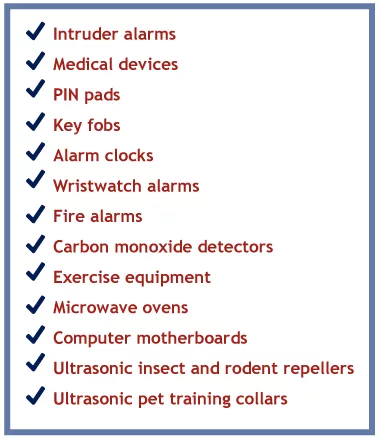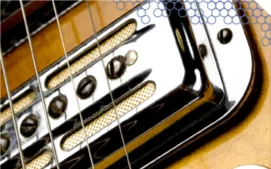The Top Uses of Piezoelectricity in Everyday Applications
What do cell phones, diesel fuel injectors, acoustic guitar pickups, grill igniters, ultrasonic transducers, vibration sensors, certain printers, and musical greeting cards all have in common? Besides being electronic devices, all of these applications utilize piezoelectricity in some way. Let’s explore how piezoelectricity works and look at some applications of piezoelectric materials in day to day life.
How Does Piezoelectric Material Work?
Dating all the way back to 1880 and the groundbreaking work of brothers Pierre and Jacques Curie, the piezoelectric effect refers to the ability of specific materials — such as quartz, tourmaline, topaz and Rochelle salt — to produce an electric charge when subjected to mechanical stress. The term “piezo” can even trace its roots back to ancient Greek, where its meanings relate to actions of pushing, squeezing and pressing.
No piezoelectric effect explanation would be complete without a brief discussion of what piezoelectric devices are as well. Today, thanks to the additional development of manmade piezo materials — including piezoelectric ceramics — the applications of piezoelectricity in electronic devices are growing at an exciting pace.
How the Piezoelectric Effect Works With Sensors and Motors
To begin with, there’s probably no more popular application of the piezoelectric effect than as a high voltage power source in electric cigarette lighters and gas grills. In these cases, a hammer strikes a piece of piezo material, which then produces enough current to create a spark that ignites the flammable gas in its presence. However, in other applications like sensors, the hammer as an exciter of the piezo material is typically replaced by other forms of energy like sound waves — including ultrasound.
When they’re put to work in sensors, piezo materials can detect even some of the most minute disturbances and anomalies, which makes them ideal devices in industrial nondestructive testing and medical imaging.
In other instances, piezoelectric motors can perform highly precise and repeatable movements. This ability makes them excellent devices for the precision movements of sensitive optical devices like telescopes and microscopes.
Piezoelectric Advantages and Disadvantages
Compared to other electronic components, piezoelectric devices have several advantages, as well as some disadvantages.
Their advantages include the following aspects:
- No external power source required: Thanks to their ability to produce a voltage when acted upon by a force, piezo materials require no external power source.
- Easy installation: With small dimensions, they’re a great fit and easily installed in high-density electronic devices.
- Responsiveness to high-frequencies: Compared to other devices, piezo materials have a substantially higher frequency response — which makes them wonderfully responsive in even the most demanding situations.
- Highly flexible materials: Most piezo materials can be constructed in a wide variety of shapes and sizes, so they’re highly useful across various applications and fields.
Piezo materials also display the following limitations or disadvantages:
- Small amount of electric charge: Though they’re self-generating, piezo materials produce fairly small electric charges, which means a high impedance cable is required to connect them to an electrical interface.
- Environmental conditions affect performance: Piezo materials are affected by temperature and changes in humidity. Plus, while in the static condition, they can’t measure output.
- Output is relatively low: While some piezo materials produce more output than others, they’re all relatively low. For their use to be optimized, an external circuit will often be required.
Piezoelectric Sensors in Industrial Applications
The industrial sector often employs piezoelectric sensors for a variety of uses. Some common, everyday uses include:
Engine Knock Sensors — Engine manufacturers are constantly facing challenges related to the control of engine parameters. Under the wrong circumstances, gasoline engines are susceptible to an undesirable phenomenon known as detonation. When detonation occurs, the air/fuel charge explodes instead of burning smoothly thereby damaging the engine. Historically, this is why most manufacturers designed engines with conservative operational margins at the expense of efficiency — it was to avoid this notorious problem.
With the development of better control systems, the relevant engine parameters may be adjusted in real-time to maximize efficiency and power. If detonation begins to occur, piezoelectric knock sensors can be employed to sense the detonation before it becomes problematic. This gives control systems time to make the required adjustments.
Pressure Sensors — In nearly any application requiring the measurement of dynamic pressure changes, using piezoelectric pressure sensors yields more reliable results than using conventional electromechanical pressure sensors. This is because piezoelectric devices have a high frequency response and signal conversion without requiring any bellows, diaphragm, or any type of mechanical linkage in conjunction with a strain gage or displacement sensor.
Sonar Equipment — Depth sounders and sonar equipment rely extensively on piezoelectric sensors to transmit and receive ultrasonic “pings” in the 50-200kHz range. Besides having an ideal frequency response for such applications, piezoelectric transducers have a high power density that enables large amounts of acoustic power to be transmitted from a small package. For instance, a transducer that is only 4” (100 mm) in diameter may be capable of handling power output greater than 500 watts.
Uses of Piezoelectric Actuators in Industrial Applications
While piezoelectric sensors are highly valuable to the industrial sector, the industry also makes use of piezoelectric actuators for a variety of applications:
Diesel Fuel Injectors — In the last decade, regulations on emissions from diesel engines have become increasingly stringent. Additionally, customers continue to demand quieter engines with improved power and torque curves. In order to meet these stringent demands for compliance and performance, engine manufacturers have resorted to using precisely timed and metered injections of fuel during the combustion process.
As incredible as this may sound, a single fuel injector may switch fuel flow with pressures exceeding 26,000 psi (1800 bar) on and off several times in rapid succession during a single power stroke. Such precise control of high-pressure fluid is made possible by using piezoelectric actuators controlling small valves within fuel injectors.
Fast Response Solenoids — Some processes require quick and precise mechanical actuation that is difficult, if not impossible, to achieve with electromagnetic solenoids. While speed may not always be a concern, power consumption or compactness of size is a top priority. In such cases, piezoelectric actuators are often able to fill the niche as they provide fast response and low power consumption in small packages, compared to electromagnetic solenoids.
Optical Adjustment — Some optics need to be adjusted or modulated with a wide frequency response and with a minimum number of moving parts. Piezoelectric actuators are often employed in such applications where they provide fast and accurate control over a long service life:
– The angle of a mirror or diffraction grating may need to be precisely varied according to an electrical input. Such applications are often encountered in optical or physics experiments.
– Earth-based telescope arrays are subject to atmospheric distortion, and spacecraft optics are subject to movement and vibration. In such cases, optics may need to be adjusted (shaped or contoured) in real-time by means of a control system. This will compensate for aberrations that would otherwise impede image resolution.
– Some fiber optic converters rely on piezoelectric actuators to modulate the output of a laser.
Ultrasonic Cleaning — Piezoelectric actuators are also used for ultrasonic cleaning applications. To perform ultrasonic cleaning, objects are immersed in a solvent (water, alcohol, acetone, etc.). A piezoelectric transducer then agitates the solvent. Many objects with inaccessible surfaces can be cleaned using this methodology.
Ultrasonic Welding — Many plastics can be joined together using a process known as ultrasonic welding. This type of process requires ultrasonic waves to be transmitted to a focused area where they can cause pieces of plastic to fuse together. Frequently, piezoelectric actuators are used to accomplish this task.
Piezoelectric Motors — One advantage of using piezoelectric materials is that their characteristics are precise and predictable. Thus, expansion and contraction of a piezoelectric actuator can be precisely controlled as long as the supply voltage is controlled. Some motor designs take advantage of this fact by using piezoelectric elements to move a rotor or linear element in precise increments. Precision on the order of nanometers can be achieved with some piezo motor designs. Piezo motors work at a wide range of frequencies but typically work best in a low frequency range.
In addition to their inherent precision, piezoelectric motors can be used in environments with strong magnetic fields or cryogenic temperatures — environments where conventional motors are unlikely to work. These unique challenges are present in NMRI machines, particle accelerators, and other similar environments.
Stack Actuators — Multiple piezoelectric elements may be stacked to multiply the displacement achieved for a given voltage. These types of devices are known as stack actuators, and they are employed in a variety of specialty applications. Compared to conventional electromagnetic actuators, stack actuators have the following unique advantages:
– They can function at cryogenic temperatures or in environments with strong magnetic fields.
– They can produce a large amount of force in a small package
– They can respond almost instantly to input with high rates of acceleration.
– They can achieve extremely high degrees of precision.
– They only consume power when work is actually being performed.
These actuators find their uses in proportioning valves, electrical relays, optical modulation, vibration dampening, and other applications requiring fast or precise control of movement.
Stripe Actuators — Two strips of piezoelectric material may be sandwiched together in a configuration that is similar to a bimetallic strip. In this configuration, the electric input causes one strip to expand while the other strip simultaneously contracts, causing a deflection.
Piezoelectric Relays — Piezoelectric elements may be implemented to actuate electromechanical relays or switches. For these applications, either stripe actuators or stack actuators may be used to open and close electrical contacts. Such devices are maintenance-free and last through many cycles without noticeable wear. As an additional benefit, using piezoelectric actuators to operate electrical contacts enables fast and precise control in small packages that are either difficult or impossible to achieve with electromagnetic relays.
Uses of Piezoelectric Sensors in Medical Applications
Take a look at how the medical field also implements piezoelectric sensors for a variety of day-to-day applications:
Ultrasound Imaging — Piezoelectric transducers are often used in medical ultrasound equipment. Advances in equipment over the decades have enabled improved monitoring of pregnancies and facilitated minimally invasive surgical procedures.
Ultrasonic Procedures — Some non-invasive medical procedures rely on the use of focused ultrasonic waves to break up kidney stones or destroy malignant tissue. Additionally, the advent of the harmonic scalpel has enabled surgeons to simultaneously incise and coagulate tissue during a surgical procedure without the need for cauterization. This leads to less tissue damage, less blood loss, and faster healing times.
Piezoelectric Actuators in Consumer Electronics
What about consumer electronics and technology that is sold in stores throughout the country? Unknown to many consumers, piezoelectric actuators are used in electronics everywhere:
Piezoelectric Printers — Generally speaking, there are two main types of printers that use piezoelectric actuators:
– a dot-matrix printer — In a piezoelectric dot matrix printer, piezoelectric actuators in the printer head move needle-like pins that “poke” through a strip of ink tape (similar to a typewriter) against a piece of paper in various patterns to form characters. For most applications, the use of dot-matrix printers has been superseded by other technologies. However, a dot-matrix printer is the only printer technology capable of generating duplicate and triplicate carbon-copy printouts.
– inkjet printer — In a piezoelectric inkjet printer, piezoelectric actuators in the printer head act on small diaphragms or otherwise change the geometry of an inkwell so that ink droplets are forced out of an orifice onto paper. This is one of the dominant technologies in the printer market to date.
Piezoelectric Speakers — Piezoelectric speakers are featured in virtually every application that needs to efficiently produce sound from a small electronic gadget. These types of speakers are usually inexpensive and require little power to produce relatively large sound volumes. Thus, piezoelectric speakers are often found in devices such as the following:
– Cell phones
– Ear buds
– Sound-producing toys
– Musical greeting cards
– Musical balloons
Piezoelectric Buzzers — Piezoelectric buzzers are similar to piezoelectric speakers, but they are usually designed with lower fidelity to produce a louder volume over a narrower frequency range. Buzzers are used in a seemingly endless array of electronic devices, including:
Piezoelectric Humidifiers — Many cool mist humidifiers use a piezoelectric transducer to transmit ultrasonic sound energy into a pool of water. The ultrasonic vibrations cause fine water droplets to break away and atomize from the surface of the pool where they become entrained in an air stream and enter the desired space.
Electronic Toothbrushes — Linear piezoelectric actuators are implemented to vibrate the bristles in some electronic toothbrushes.
Piezoelectric Materials for Musical Applications
Aside from technological and industrial applications, piezoelectricity also benefits the arts. There are a variety of musical applications that use piezoelectricity:
Instrument Pickups — Many acoustic-electric stringed instruments utilize piezoelectric pickups to convert acoustic vibrations to electric signals. Typically, a strip of piezoelectric material is placed between the instrument body and a structure that supports the strings. For instance, an acoustic-electric guitar usually houses its piezoelectric strip beneath the bridge and within the saddle. As the strings vibrate, the strip is agitated to generate an electric signal. Electric pickups on violins, violas, and cellos use the same concept, but the piezoelectric pickup may be clamped to the bridge or integrated within the bridge — instead of being located between the bridge and the instrument body.
Microphones — Some microphones (such as contact microphones for percussion instruments) use piezoelectric materials to convert sound vibrations to an electrical output. These microphones generally possess high output impedances that must be matched when designing their respective pre-amplifiers.
Using Piezoelectricity in Other Applications
Do you have an application that wasn’t listed on the list? Are you wondering if you can use piezoelectricity? The following uses of piezoelectricity represent other options for your industry:
Piezoelectric Ignitors — This is, perhaps, the most well-known and ubiquitous use of piezoelectricity. In a piezoelectric igniter, a button or trigger is used to cock and release a spring-loaded hammer, and the hammer is used to strike a rod shaped piezoelectric ceramic. The sudden mechanical shock to the piezoelectric ceramic produces a rapid rise in voltage that is high enough to jump a sizeable spark gap and ignite fuel. Piezoelectric igniters are commonly used for butane lighters, gas grills, gas stoves, blowtorches, and improvised potato cannons.
Electricity Generation — Some applications require the harvesting of energy from pressure changes, vibrations, or mechanical impulses. The harvesting of energy is possible by using piezoelectric materials to convert deflections or displacements into electrical energy that can either be used or stored for later use.
Microelectronic Mechanical Systems (MEMS) — MEMS devices have become more commonplace as more integrated capabilities are required in smaller packages, such as cell phones, tablet computers, etc. The advantage of MEMS devices is that gyroscopes, accelerometers, and inertial measuring devices can be integrated into chip-sized packages. In order to accomplish such a feat, piezoelectric actuators and sensors are often used.
Tennis Racquets — A somewhat unusual application for piezoelectricity integrates piezoelectric fibers into the throat of a tennis racquet along with a microcontroller in the handle. When the tennis player strikes the ball, the racquet frame deflects and generates an electric output that is boosted, reversed, and fed back into the fibers. This is an attempt to cause destructive interference and dampen structural vibration.
Using Piezoelectricity in Defense Applications
If you’re a part of the defense industry, you can use piezoelectricity for a variety of applications:
Micro Robotics — In the field of small robotics, small power-efficient mechanical actuators and sensors are needed. With the use of piezoelectric actuators, building something as small as a robotic fly that can crawl and fly is technically feasible. In fact, a new field of robotic technology known as Micro Air Vehicles aims to build small drones the size of insects or birds that fly using flapping wings. They control surfaces just as birds and insects do. These types of feats in miniaturization are possible, in part, by using piezoelectric actuators.
Course-changing Bullets — Recently, DARPA invented a .50-caliber bullet that can change course in mid-flight. As absurd as this innovation may sound to some readers, the bullet uses an optical sensor that is mounted on its nose in conjunction with a control system and moveable tail fins to steer itself toward a laser-illuminated target. Although DARPA has not revealed much about their Extreme Accuracy Tasked Ordinance (EXACTO) bullet, the most likely means of manipulating the tail fins probably involves piezoelectric actuators.
Count Us In
If you wish to explore the world of using piezoelectricity or learn more about what APC International can offer, take a look at our product and service offerings. Contact our team with any questions or visit our knowledge center today.
Read More Popular Posts From APC International
Piezoelectric Effect vs. Piezoresistive Effect
History and Development of Ultrasound Technology
Medical Applications of Ultrasonic Transducers
Piezoelectricity & Wearable Technology
Technology Generates Functional Benefits






No Comments